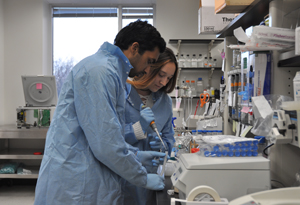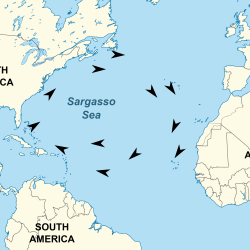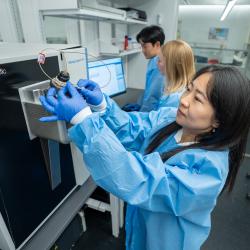Science Terps’ Microbiology Experiment Returns from International Space Station
Rushi Challa and Natalie Ivanina’s experiment tested how well viruses could attack bacteria in microgravity
Two University of Maryland undergraduates designed an experiment that returned from the International Space Station (ISS) on August 3, 2018, as part of the Student Spaceflight Experiments Program (SSEP). Astronauts on the ISS carried out the students’ experiment to find out how well viruses can attack bacteria in microgravity.
 “I’ve wanted to be an astronaut since the third grade,” said team member Rushi Challa, who is seeking dual degrees in biological sciences and psychology. “Having a project that I worked on deemed as worthy of traveling into space is incredibly exciting.”
“I’ve wanted to be an astronaut since the third grade,” said team member Rushi Challa, who is seeking dual degrees in biological sciences and psychology. “Having a project that I worked on deemed as worthy of traveling into space is incredibly exciting.”
Challa met and teamed up with Natalie Ivanina (B.S. ’18, biological sciences) at an SSEP information session in 2016. The pair designed an experiment to study how well T4 bacteriophage—viruses that specifically kill E. coli bacteria—attack their prey in microgravity.
“Sterility is extremely important in a closed environment like the ISS,” Ivanina explained. “Right now, astronauts use chemical cleaners, but those have harmful fumes. We think bacteriophage are a potentially safer solution because they only kill their target bacteria and are harmless to everything else, including humans.”
Challa and Ivanina’s experiment seeks to determine whether bacteriophage can successfully attack bacteria in space and whether bacteriophage are more infectious in space.
The students prepared a mixture of dormant E. coli and T4 bacteriophage for the astronauts to activate in space. Once activated, the bacteriophage infected the bacteria. Two days after activation, the astronauts added a chemical to the mixture that killed the bacteria and viruses while preserving their RNA and DNA.
In parallel, Challa and Ivanina carried out the same experiment on Earth. Once they receive their samples from the ISS, the students will isolate the RNA and DNA from both samples for analysis and comparison.
During a successful infection, bacteriophage replicate themselves and their DNA. A high ratio of bacteriophage DNA to bacteria DNA suggests a more successful infection. The students will compare the ratio from both samples to determine how well the bacteriophage infected bacteria on Earth versus in microgravity.
If the students detect a difference in infectiousness between space and Earth, they will investigate possible causes of the difference. They currently have two hypotheses. Reduced infectivity in space could be caused by bacteria’s ability to develop thicker protective walls in microgravity. Alternatively, increased infectivity could be caused by the ability of organisms to move more easily in microgravity, which could lead to bacteriophage attacking more bacteria.
The students will test their hypotheses by honing in on the genes involved in each scenario and examining how active those genes were in the microgravity sample. For example, high activity levels of genes that encode endolysins—enzymes that T4 bacteriophage need to attack E. coli—would support the second scenario.
“If we could further this experiment, we would study more endolysins from other bacteriophage,” Challa said. “It might be possible to make a cocktail of different types of endolysins to kill many kinds of bacteria, not only E. coli.”
Challa and Ivanina will perform their analyses in the laboratory of Daniel Nelson, an associate professor in the Institute for Bioscience and Biotechnology Research with an appointment in veterinary medicine. The students performed preliminary experiments in Nelson’s lab to calibrate the mixture of dormant bacteriophage and bacteria to send aboard the ISS.
“Dr. Nelson and his graduate student, Irina Etobayeva, have been incredibly helpful,” said Ivanina. “They taught us how to perform preliminary experiments and helped direct us to publications that gave us great insights for analyses we will need to do once the samples return. On top of it all, they offered us some funding for the project. We couldn’t have come this far without them.”
The students also acknowledge help and guidance from Daniel Serrano, a faculty specialist in the Institute for Research in Electronics and Applied Physics who currently directs Terps in Space, the University of Maryland’s SSEP community, which chooses one team every year to send an experiment to the ISS.
The students hope to publish a paper on their results and inspire further research on bacteriophage.
“Bacteriophage were studied ages ago as treatments for bacterial infections until antibiotics were discovered,” Ivanina said. “But antibiotic resistance is currently rising, so I think it could be worth studying them again for human health.”
Both students will remain involved with medicine and research after this project concludes. Ivanina will conduct research at the Uniformed Services University of the Health Sciences for the next two years. She will also succeed Serrano as director of Terps in Space.
Challa will attend medical school at the George Washington University School of Medicine & Health Sciences after he graduates in 2019.
“My goal is to become a doctor and to use my degree to work with space-related science,” said Challa, who also has a pilot’s license. “Being a part of NASA would be phenomenal. And of course, I’m still eager to become an astronaut!”
###
SSEP is a program of the National Center for Earth and Space Science Education (NCESSE) in the U.S. and the Arthur C. Clarke Institute for Space Education internationally. It is enabled through a strategic partnership with DreamUp PBC and NanoRacks LLC, which are working with NASA under a Space Act Agreement as part of the utilization of the International Space Station as a National Laboratory.
Media Relations Contact: Irene Ying, 301-405-5204, zying@umd.edu
University of Maryland
College of Computer, Mathematical, and Natural Sciences
2300 Symons Hall
College Park, MD 20742
www.cmns.umd.edu
@UMDscience
About the College of Computer, Mathematical, and Natural Sciences
The College of Computer, Mathematical, and Natural Sciences at the University of Maryland educates more than 9,000 future scientific leaders in its undergraduate and graduate programs each year. The college’s 10 departments and more than a dozen interdisciplinary research centers foster scientific discovery with annual sponsored research funding exceeding $175 million.







